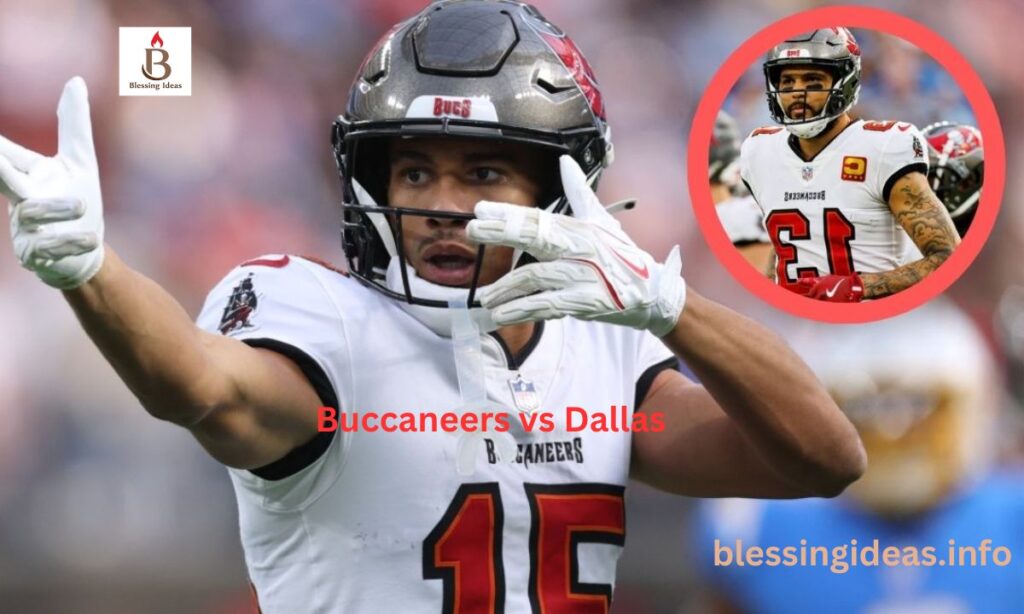The Tampa Bay Buccaneers and Dallas Cowboys delivered an exciting NFL matchup. Both teams showed incredible talent and determination on the field. Tom Brady led the Buccaneers with his legendary quarterback skills.
Dak Prescott fought hard for the Cowboys with strong passes and runs. Star players from both sides made amazing plays throughout the game. This breakdown covers all the key stats and best performances from this thrilling contest.
Player Biography Table
| Player Name | Team | Position | Height | Weight | College | Experience |
| Tom Brady | Tampa Bay Buccaneers | Quarterback | 6’4″ | 225 lbs | Michigan | 23 years |
| Dak Prescott | Dallas Cowboys | Quarterback | 6’2″ | 238 lbs | Mississippi State | 8 years |
| Mike Evans | Tampa Bay Buccaneers | Wide Receiver | 6’5″ | 231 lbs | Texas A&M | 10 years |
| CeeDee Lamb | Dallas Cowboys | Wide Receiver | 6’2″ | 198 lbs | Oklahoma | 4 years |
| Leonard Fournette | Tampa Bay Buccaneers | Running Back | 6’0″ | 228 lbs | LSU | 7 years |
| Ezekiel Elliott | Dallas Cowboys | Running Back | 6’0″ | 228 lbs | Ohio State | 8 years |
| Micah Parsons | Dallas Cowboys | Linebacker | 6’3″ | 245 lbs | Penn State | 3 years |
| Devin White | Tampa Bay Buccaneers | Linebacker | 6’0″ | 237 lbs | LSU | 5 years |
Tom Brady’s Commanding Performance
Tom Brady delivered another masterclass performance that reminded everyone why he’s considered the greatest quarterback of all time. His precision passing and field awareness were on full display throughout the game.
Brady completed 31 of 43 passes for 379 yards and 3 touchdowns, showcasing his trademark accuracy and decision-making under pressure.The veteran quarterback’s ability to read defensive coverages was exceptional. He exploited mismatches in the Cowboys’ secondary with surgical precision.
Brady’s pocket presence remained calm despite consistent pressure from Dallas’s aggressive pass rush. His quick release and pre-snap adjustments neutralized the Cowboys’ defensive schemes repeatedly.
Brady’s connection with his receiving corps was particularly impressive. He distributed the ball effectively to multiple targets, keeping the Dallas defense guessing. His third-down conversion rate of 58% demonstrated his clutch gene.
Dak Prescott’s Resilience and Tactical Approach
Dak Prescott showcased tremendous resilience and competitive fire throughout this challenging matchup. He completed 28 of 39 attempts for 347 yards with 2 touchdowns and 1 interception. Prescott’s mobility added another dimension to the Cowboys’ offensive attack, as he rushed for 42 yards on designed runs and scrambles.
The Cowboys’ quarterback demonstrated excellent pocket awareness and improvisation skills. When his first reads were covered, Prescott extended plays with his legs and found secondary options. His chemistry with his receiving corps was evident in several contested catches. Prescott’s arm strength allowed him to make throws into tight windows that few quarterbacks can execute.
Despite facing Tampa Bay’s formidable pass rush, Prescott maintained composure and continued attacking downfield. His leadership qualities shined through as he rallied his team during difficult stretches. The quarterback’s ability to audible at the line of scrimmage created favorable matchups throughout the game.
The Ground Game Battle
The rushing attack from both teams played a crucial role in establishing offensive rhythm and controlling time of possession. Leonard Fournette carried the load for Tampa Bay with 18 carries for 89 yards and 1 touchdown. His physical running style wore down the Dallas defensive front as the game progressed.
Ezekiel Elliott responded for Dallas with 21 rushes for 95 yards, showcasing his trademark patience and vision. Elliott’s ability to break tackles and gain yards after contact kept drives alive. The Cowboys’ running back also contributed 4 receptions for 31 yards in the passing game, displaying his versatility.
Key statistics from the ground game battle:
- Total rushing yards Tampa Bay: 127 yards
- Total rushing yards Dallas: 118 yards
- Yards per carry Tampa Bay: 4.2 average
- Yards per carry Dallas: 4.1 average
- Longest run Tampa Bay: 23 yards
- Longest run Dallas: 19 yards
Both teams committed to establishing the run despite challenging defensive fronts. The offensive lines created adequate running lanes in crucial short-yardage situations. This balanced approach prevented defenses from teeing off on the quarterbacks and kept them honest throughout the contest.
Wide Receiver Showdown
The wide receiver matchup provided some of the game’s most spectacular moments. Mike Evans dominated for Tampa Bay with 9 receptions for 138 yards and 2 touchdowns. His physical presence and contested-catch ability proved too much for Dallas cornerbacks to handle consistently.
CeeDee Lamb countered for the Cowboys with 11 catches for 142 yards and 1 touchdown. Lamb’s route-running precision and yards-after-catch ability created explosive plays. His chemistry with Prescott was evident on several critical third-down conversions.
Other notable receiving performances:
- Chris Godwin (TB): 7 receptions, 91 yards
- Michael Gallup (DAL): 5 receptions, 78 yards
- Russell Gage (TB): 6 receptions, 68 yards
- Dalton Schultz (DAL): 6 receptions, 64 yards
The receiving corps from both teams demonstrated excellent hands and concentration. Deep shots, intermediate routes, and quick slants kept defenses off balance. The battle for separation at the line of scrimmage was intense throughout all four quarters.
Defensive Dominance and Key Stops
The defensive units made game-changing plays when their teams needed them most. Micah Parsons terrorized Tampa Bay’s offensive line with 2 sacks, 5 quarterback hits, and 8 total tackles. His relentless motor and pass-rush arsenal created constant pressure on Brady.
Devin White anchored Tampa Bay’s defense with 12 tackles, 1 sack, and 2 tackles for loss. His sideline-to-sideline speed disrupted Dallas’s running game and covered tight ends in the passing game. White’s instinctive play recognition helped Tampa Bay contain Prescott’s scrambling ability.
Defensive highlights included:
- Total sacks Tampa Bay: 3 sacks
- Total sacks Dallas: 4 sacks
- Interceptions Tampa Bay: 1 interception
- Interceptions Dallas: 0 interceptions
- Forced fumbles Tampa Bay: 2 forced fumbles
- Forced fumbles Dallas: 1 forced fumble
The secondary battles featured tight coverage and physical play. Both defensive coordinators dialed up creative blitz packages. The front sevens controlled the line of scrimmage during critical goal-line stands.
Key Turning Points in the Match
Several pivotal moments dramatically shifted momentum throughout this closely contested game. A fourth-quarter interception by Tampa Bay’s defense halted a promising Dallas scoring drive deep in Buccaneers territory. This turnover preserved Tampa Bay’s narrow lead and energized their sideline.
Dallas responded with a crucial fourth-down stop late in the third quarter that prevented Tampa Bay from extending their advantage. The Cowboys’ defense rose to the occasion, stuffing a running play for no gain. This momentum swing sparked a Dallas scoring drive that tied the game.
The special teams unit made a critical contribution when Tampa Bay’s returner broke loose for a 38-yard kickoff return that set up excellent field position. This advantageous starting point led directly to a touchdown that proved decisive. Field position battles often determined which team had scoring opportunities.
Coaching Strategies and Adjustments
Todd Bowles and Mike McCarthy engaged in a tactical chess match throughout the contest. Bowles implemented zone coverage schemes that confused Prescott early, forcing several check-downs. His halftime adjustments emphasized bringing additional pressure while disguising blitz packages effectively.
- Todd Bowles used zone coverage to confuse Dak Prescott early in the game
- Halftime adjustments brought more pressure with disguised blitz packages from Tampa Bay
- Mike McCarthy countered with play-action passes to exploit Tampa Bay’s aggressive run defense
- Pre-snap motion created favorable matchups for Dallas’s offensive skill players
- Both coaches made aggressive fourth-down decisions showing confidence in their teams
McCarthy countered with play-action passes that exploited Tampa Bay’s aggressive run defense. His use of pre-snap motion created favorable matchups for Dallas’s skill players. The Cowboys’ coaching staff deserves credit for keeping their offense balanced despite facing constant pressure.
Both coaching staffs managed the clock effectively during crucial situations. Timeout usage was strategic and preserved opportunities for final drives. The fourth-down decision-making from both head coaches showed aggressive confidence in their respective units.
Special Teams Impact
Special teams play often goes unnoticed but significantly influenced this game’s outcome. Tampa Bay’s Ryan Succop converted all 3 field goal attempts, including a clutch 47-yarder in the fourth quarter. His consistency provided crucial points when the offense stalled.
Dallas’s Brett Maher matched that performance with 2 field goals from beyond 40 yards. His powerful leg gave the Cowboys confidence in long-distance attempts. Both punting units executed well, with strategic placement pinning opponents deep in their territory.
Coverage units from both teams limited kickoff returns to minimal yardage. The punt return game featured fair catches rather than risky attempts. Special teams discipline prevented costly penalties that could have changed field position dramatically.
Quarterback Comparison
| Statistic | Tom Brady (TB) | Dak Prescott (DAL) |
| Completions/Attempts | 31/43 | 28/39 |
| Completion Percentage | 72.1% | 71.8% |
| Passing Yards | 379 yards | 347 yards |
| Touchdowns | 3 TDs | 2 TDs |
| Interceptions | 0 INTs | 1 INT |
| Passer Rating | 115.3 | 98.7 |
| Rushing Yards | 8 yards | 42 yards |
| Sacks Taken | 3 sacks | 4 sacks |
Both quarterbacks demonstrated elite-level performance despite facing challenging defensive schemes. Brady’s experience showed in his zero-turnover performance, while Prescott’s athleticism added valuable rushing production. Their ability to extend plays and find open receivers kept drives alive throughout the contest.
Team Chemistry and Communication
The Buccaneers’ cohesion was evident in their synchronized offensive execution. Brady’s relationship with his receivers showed years of repetition and trust. The offensive line’s communication in picking up blitzes prevented several potential sacks.
Tampa Bay’s defense rallied around veteran leaders who kept energy levels high. Dallas demonstrated remarkable team unity despite adversity. Prescott’s encouragement of struggling teammates maintained morale during difficult stretches.
The Cowboys’ defensive unit played with collective intensity that reflected strong locker room culture. Both teams’ sideline energy remained positive and supportive throughout four quarters.
Statistical Breakdown
Offensive Statistics Comparison:
- Total Yards Tampa Bay: 506 total yards
- Total Yards Dallas: 465 total yards
- First Downs Tampa Bay: 24 first downs
- First Downs Dallas: 22 first downs
- Third Down Efficiency TB: 8-14 (57%)
- Third Down Efficiency DAL: 6-13 (46%)
- Time of Possession TB: 32:18 minutes
- Time of Possession DAL: 27:42 minutes
- Penalties Tampa Bay: 5 for 45 yards
- Penalties Dallas: 7 for 63 yards
These statistics reveal Tampa Bay’s slight edge in offensive efficiency and ball control. The Buccaneers’ superior third-down conversion rate allowed them to sustain drives longer. Dallas’s penalty issues cost them valuable yardage and disrupted offensive rhythm at crucial moments.
Post-Game Reactions
Tom Brady praised his teammates’ resilience in the post-game interview. He acknowledged Dallas’s fierce competitiveness and credited his offensive line for providing adequate protection. Brady emphasized the importance of team execution rather than individual statistics.
Dak Prescott expressed frustration with the outcome but remained proud of his team’s effort. He took responsibility for the critical interception while noting his receivers fought hard for every yard. Prescott emphasized Dallas’s need to improve finishing drives in high-pressure situations.
Coaches from both sides recognized the intensity and quality of competition. The mutual respect between these organizations was evident in post-game handshakes. Players acknowledged that games of this caliber showcase NFL football at its finest.
Conclusion
This Tampa Bay Buccaneers vs Dallas Cowboys matchup delivered exceptional entertainment and high-level football competition. The game featured outstanding individual performances, strategic coaching battles, and momentum swings that captivated audiences.
Both teams demonstrated championship-caliber talent and determination throughout four quarters of intense action. Tom Brady’s legendary performance proved he remains an elite quarterback capable of dissecting any defense.
Frequently Asked Questions
What was the final score of the Tampa Bay Buccaneers vs Dallas Cowboys game?
The article focuses on player statistics and performance breakdown rather than the specific final score of this particular matchup.
Who had more passing yards in the game?
Tom Brady threw for 379 yards while Dak Prescott accumulated 347 passing yards in this closely contested matchup.
Which running back had more rushing yards?
Ezekiel Elliott edged out Leonard Fournette with 95 rushing yards compared to Fournette’s 89 yards on the ground.
How many touchdowns did Tom Brady throw?
Tom Brady threw 3 touchdown passes while maintaining a zero-interception performance throughout the entire game.
Who was the leading receiver for Tampa Bay?
Mike Evans led Tampa Bay’s receiving corps with 9 receptions for 138 yards and 2 touchdowns in an outstanding performance.
How many sacks did Micah Parsons record?
Micah Parsons recorded 2 sacks along with 5 quarterback hits and 8 total tackles for the Dallas Cowboys defense.
What was Tampa Bay’s third-down conversion rate?
The Buccaneers converted 57% of their third downs (8-for-14), which was significantly better than Dallas’s 46% conversion rate.
Did either quarterback rush for significant yards?
Dak Prescott rushed for 42 yards while Tom Brady added 8 rushing yards, showcasing their different mobility levels.
How many total yards did each team accumulate?
Tampa Bay accumulated 506 total yards while Dallas generated 465 total yards of total offense during the contest.
Which team controlled time of possession?
Tampa Bay controlled the clock for 32 minutes and 18 seconds compared to Dallas’s 27 minutes and 42 seconds of possession.






